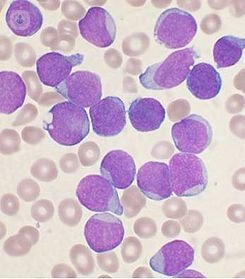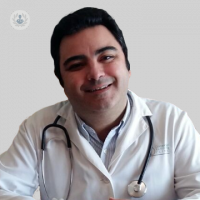Leukemia know what and how to go
Written by:Leukemia is cancer of the bone marrow found in the flat bones. They can be acute or chronic and is the most common cancer in children. His diagnosis is very important to administer treatment as soon as possible. Research continues in search of a cure.

Leukemia: what it is and types
Leukemia comes from the Greek Leukos (white) and haima (blood). It is defined as a cancer of the bone marrow that is within the flat bones. In this cancer a malignant cells called blasts in known as Acute leukemias or cells in a state of maturation but aberrant increase in what are termed chronic leukemias, that may originate from any of the precursors of blood cellularity (RBCs , white blood cells and cytological varieties: granulocytes, monocytes, lymphocytes, and platelets). Consequently it results in decreased production and maturation other haematological series. Cancer cells can spread from the bone marrow into the bloodstream, lymph nodes, spinal cord and central nervous system and other body parts
Prevalence of Leukemia
We can say that leukemia is the most common type of childhood cancer, with an incidence of 3 to 5 cases per 100,000 children / year, especially in its acute variety. In adults the incidence is variable and ranges from 1.3 cases / 100,000 population per year with a prevalence rate between 1.5-7 depends% of all tumors.
On the other hand though there is no single known cause for various types of leukemia exist, those factors that are known and which are not intrinsic to each patient, they represent relatively few cases; so that each can have different leukemia variety of different causes.
Causes and origins of Leukemia
Leukemia, like most tumors are the result of a mutation of one or more genes producing activating substances called oncogenes or inactivation of genes that produce tumor suppression, which alters the control cycle death or cell apoptosis, differentiation or proliferation. These mutations can occur either spontaneously or as a result of exposure to radiation or chemical carcinogens, in addition to the likely influence of certain genetic predisposition substances.
Among the most common factors that have been associated with the production of certain types of leukemia are:- Infection with certain types of virus- Ionizing radiation- Chemicals such as alkylating agents- Benzene- Certain types of chemotherapeutics- The snuff- Some petrochemicals- Hair dyes, etc.
There are reports also of transmission between mother and fetus, as well as certain chromosomal abnormalities such as Down syndrome or Fanconi anemia.
A controversial fact is exposure to non-ionizing energy. According to expert commissions they have concluded that exposure to electromagnetic fields electrical low frequency could double the incidence of childhood leukemia. Although there are a priori contradictory data, which is concluded is that real annual incidence ranges from 0.20 to 5%.
Symptoms of Leukemia
In the case of those chronic leukemias, the clinic is more insidious, even can often go unnoticed with a slow evolution, whereas in acute leukemic processes symptomatology is more florid, with a quick course.
In summary, to power any cell line affected hematologic extirpates, the symptoms are varied. Some characteristic symptoms may include:- Decay, lack of strength, dizziness, nausea, vomiting, loss of appetite, weight loss important- Fever without apparent cause, which can last several weeks- Pain and increased sensitivity bone, joint and / or limb- Frequent bleeding for no apparent reason- Pale skin and mucous- Enlarged lymph nodes
Diagnosis of Leukemia
As in any hematologic process the diagnostic approach must be systematic and structured, starting with a good anamnesis, inquiring among family or personal history, followed by a structured physical examination for indirect signs that can make us suspect the etiologic process: peripheral lymphadenopathy , visceromegalies, bleeders, pallor, cachexia, etc.
As mentioned above, the specialist in hematology make appropriate analytical laboratory and morphological studies that may include genetic testing or immunohistochemistry or cytology to label the leukemic box.
It will be necessary, if preliminary results suggest so, turn to the study of plant blood or bone marrow to see if there are signs of disease on it.
Finally, they can be useful imaging tests to assess the degree of spread of the disease.
Treatment and Prognosis Leukemia
Treatment and prognosis depend mainly on the type of leukemia in question and can go from simple observation to systematic application of chemotherapy and radiation therapy, or hematopoietic stem cell transplantation in the case of acute leukemias protocols.
The outcome will depend mainly of:- The type of entity etiological- The response to initial treatments- The presence or absence of certain types of oncogenes or chromosomal mutations- age- The presence or not of conmorbilidades
Can you cure leukemia?
Although today we are still far from finding a cure for this disease, the cure rate is low, below 15%. Today, for most of these clinical entities, the only curative option with a morbidity rate of up to 35-45% of cases allogeneic transplantation of hematopoietic progenitors. Although this therapy has evolved considerably since its inception back in the 60s, it is now available less aggressive procedures called microtrasplantes, with an acceptable response rate, although increasing the likelihood of relapse.
A couple of years ago was successfully tested in USA the first therapy in a patient with acute leukemia by gene therapy through a vector (attenuated measles virus) that managed to cure disease. However, studies are still needed for the development and assessment of the benefit of this type of treatment.


